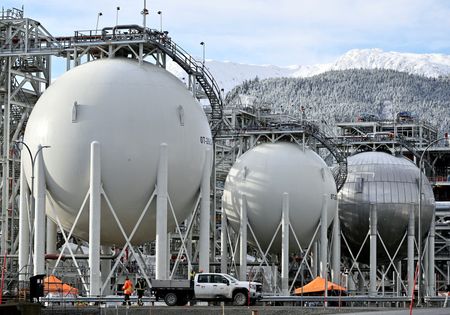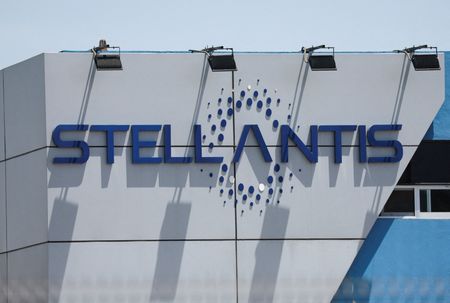By Marwa Rashad, Curtis Williams and Amanda Stephenson
LONDON/HOUSTON/CALGARY (Reuters) -Shell-led LNG Canada is experiencing technical problems as it ramps up production at its liquefied natural gas plant at Kitimat, with one LNG tanker diverting away from the facility without the superchilled fuel in recent days, according to four sources and LSEG ship tracking data.
The plant is the first major LNG export facility in Canada and the first on the west coast of North America, providing direct access to Asia, the world’s largest LNG market.
The facility is expected to convert about 2 billion cubic feet of gas per day (bcfd) to LNG when fully operational, which market participants have hoped will boost Canadian natural gas prices.
Western Canadian natural gas prices remain depressed, however, due to a persistent supply glut that has not yet been drawn down by fresh demand from LNG Canada’s July 1 startup.
The daily spot price at the Alberta Energy Company (AECO) storage hub closed at $0.22 per mmBtu on Tuesday, compared to the U.S. Henry Hub benchmark price of $3.12, according to LSEG data.
LNG Canada, which took almost seven years to be built, has been operating at less than half the capacity of its first plant, also called a train, two of the four sources said.
The facility’s Train 1 has experienced technical issues with a gas turbine and with a Refrigerant Production Unit (RPU), according to two other industry sources.
The sources all spoke on condition of anonymity because the information was not public.
In response, a LNG Canada spokesperson said a new-build facility at the joint venture’s size and scale may face operational setbacks as it ramps up production and stabilizes.
There has been at least one diversion by Shell of an empty LNG vessel to Peru, while other tankers remain close to the facility, LSEG ship tracking data showed.
Ferrol Knutsen, a 170,520 cubic meters LNG tanker, was signaling that it was headed to the Kitimat port but then changed directions and is now off the coast of California on its way to Peru, according to LSEG ship tracking data.
LNG Canada is a joint venture between Shell, Malaysia’s Petronas, PetroChina, Japan’s Mitsubishi Corp and South Korea’s KOGAS.
When fully operational, LNG Canada will have a capacity to export 14 million metric tonnes per annum (mtpa), according to company statements.
So far the facility has exported four cargoes, including its first shipment on July 1. Another shipment is expected in the coming days, the LNG Canada spokesperson said.
The pace of exports from the plant will increase as it moves through early operations and into a steady shipping cadence, the spokesperson said.
“In regular operations in Phase 1, we anticipate loading one export cargo from our facility every two days,” the spokesperson added.
(Reporting by Marwa Rashad in London, Curtis Williams in Houston and Amanda Stephenson in Calgary; Editing by Liz Hampton and Jamie Freed)









